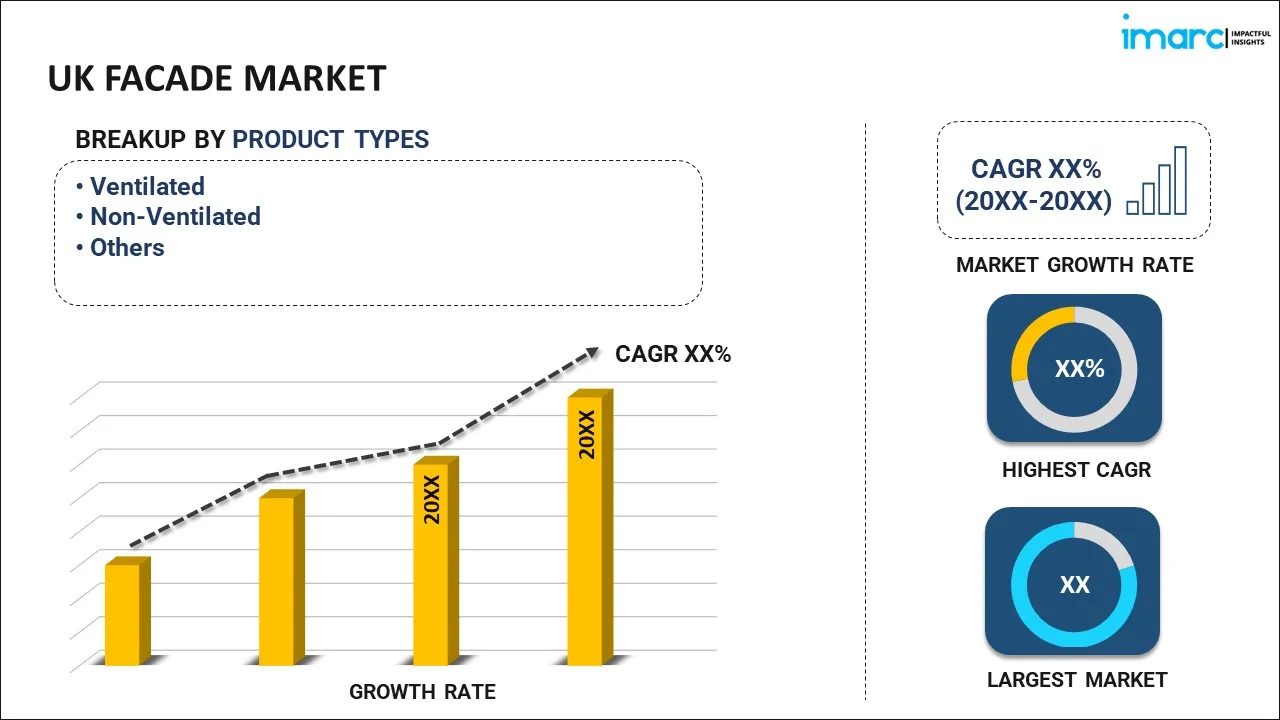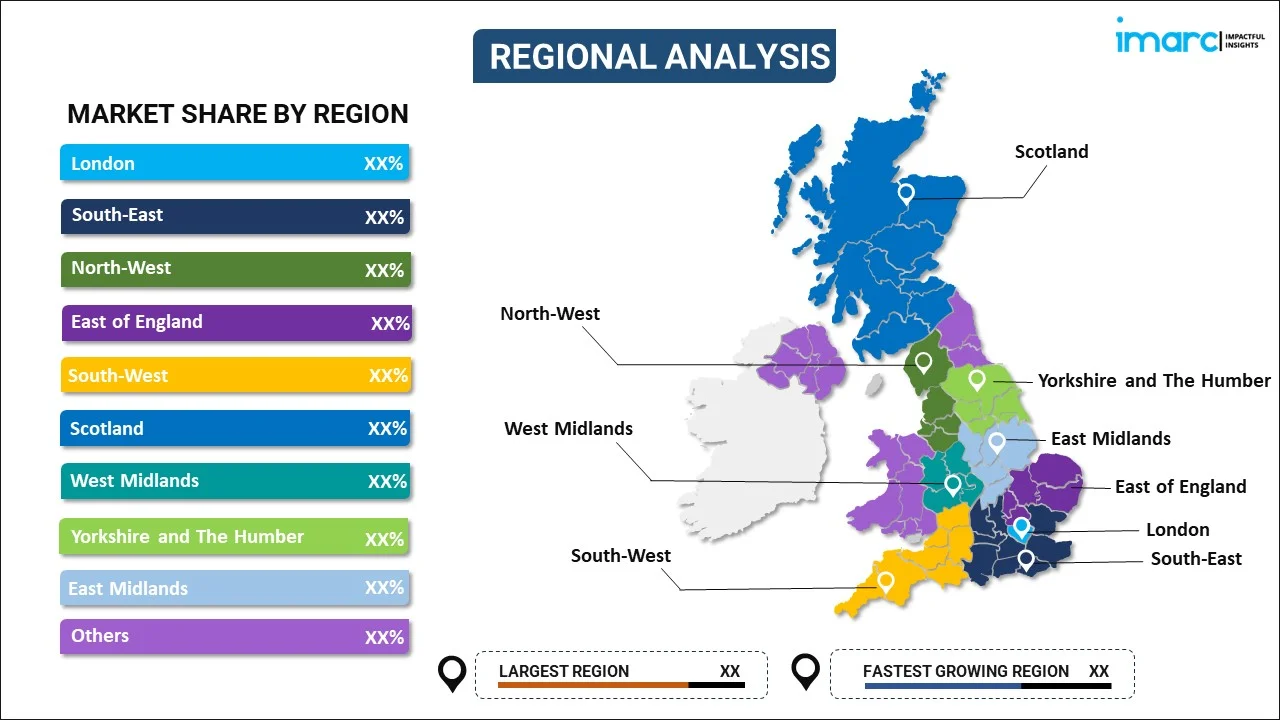
UK Facade Market Report by Product Type (Ventilated, Non-Ventilated, and Others), Material (Glass, Metal, Plastic and Fiber, Stones, and Others), End Use (Commercial, Residential, Industrial), and Region 2025-2033
UK Facade Market Overview:
The UK facade market is projected to exhibit a growth rate (CAGR) of 6.10% during 2025-2033The increasing demand for energy-efficient buildings, a focus on sustainable architecture, significant developments in construction technology, the rising popularity of aesthetic and innovative facade designs, and favorable investments in commercial and residential real estate are primarily driving the UK facade market.
|
Report Attribute
|
Key Statistics
|
|---|---|
|
Base Year
|
2024 |
|
Forecast Years
|
2025-2033
|
|
Historical Years
|
2019-2024
|
| Market Growth Rate (2025-2033) | 6.10% |
UK Facade Market Trends:
Retrofitting and Refurbishment Projects
Retrofitting and refurbishment of existing buildings are becoming more prevalent in the UK facade market. With a significant portion of the building stock being older, there is a growing need to update facades to meet modern energy efficiency standards and aesthetic preferences. This trend is supported by government incentives and regulations aimed at reducing carbon emissions and improving building performance. For instance, five years after the Grenfell fire, which claimed 72 lives, the government has banned the specific type of cladding that allowed the blaze to spread so quickly. Metal composite panels with an unmodified polyethylene core are now prohibited on buildings of any height. Facade materials are crucial for fire safety, as the building's exterior is directly exposed to fire. As a result, facade materials will be subject to stringent regulations in the future.
Advent of Advanced Facade Technologies
The integration of advanced technologies is a significant trend in the UK facade market. Smart facades, which include dynamic glass that can adjust its opacity based on sunlight, and integrated photovoltaic panels for energy generation, are becoming more popular. These technologies not only improve the building’s energy efficiency but also enhance comfort and functionality for occupants. The adoption of Building Information Modeling (BIM) for facade design and maintenance is also on the rise, improving precision and reducing construction costs and time. For instance, after 2022, the Building Regulations in UK requires newer construction to have lower co2 emissions with a reduction of around 27% from commercial buildings. Buildings currently account for over 40% of the total UK energy consumption and a similar percentage of the UK CO2 emissions. On a per-household basis, domestic energy consumption increased by 5% in 2021. With such a drive towards energy usage reduction, energy-efficient facades become important.
UK Facade Market News:
- In March 2024, Permasteelisa Group, a global leader in the design, construction, and installation of advanced buildings, was appointed to deliver the glazing and cladding for St. John’s Wood Square, a prestigious new development in central London. This project involves redeveloping the 5.5-acre former St. John’s Wood Barracks, previously occupied by the King’s Troop, Royal Horse Artillery. The residential development will feature nine buildings, ranging from 3 to 6 stories high, offering a total of 179 residential units.
- In April 2024, SAPA moved a step closer toward pioneering a more sustainable future by becoming the first aluminum building system company to manufacture door, window, and facade profiles from 100% recycled aluminum, known as Hydro CIRCAL 100R. This innovative material is made entirely from recycled post-consumer scrap.
UK Facade Market Segmentation:
IMARC Group provides an analysis of the key trends in each segment of the market, along with forecasts at the country level for 2025-2033. Our report has categorized the market based on product type, material, and end use.
Product Type Insights:

- Ventilated
- Non-Ventilated
- Others
The report has provided a detailed breakup and analysis of the market based on the product type. This includes ventilated, non-ventilated and others.
Material Insights:
- Glass
- Metal
- Plastic and Fiber
- Stones
- Others
A detailed breakup and analysis of the market based on the material have also been provided in the report. This includes glass, metal, plastic and fiber, stones and others.
End Use Insights:
- Commercial
- Residential
- Industrial
The report has provided a detailed breakup and analysis of the market based on the end use. This includes commercial, residential and industrial.
Regional Insights:

- London
- South East
- North West
- East of England
- South West
- Scotland
- West Midlands
- Yorkshire and The Humber
- East Midlands
- Others
The report has also provided a comprehensive analysis of all the major regional markets, which include London, South East, North West, East of England, South West, Scotland, West Midlands, Yorkshire and The Humber, East Midlands, and Others.
Competitive Landscape:
The market research report has also provided a comprehensive analysis of the competitive landscape in the market. Competitive analysis such as market structure, key player positioning, top winning strategies, competitive dashboard, and company evaluation quadrant has been covered in the report. Also, detailed profiles of all major companies have been provided.
UK Facade Market Report Coverage:
| Report Features | Details |
|---|---|
| Base Year of the Analysis | 2024 |
| Historical Period | 2019-2024 |
| Forecast Period | 2025-2033 |
| Units | xx |
| Scope of the Report | Exploration of Historical Trends and Market Outlook, Industry Catalysts and Challenges, Segment-Wise Historical and Future Market Assessment:
|
| Product Types Covered | Ventilated, Non-Ventilated, Others |
| Materials Covered | Glass, Metal, Plastic and Fiber, Stones, Others |
| End Uses Covered | Commercial, Residential, Industrial |
| Regions Covered | London, South East, North West, East of England, South West, Scotland, West Midlands, Yorkshire and The Humber, East Midlands, Others |
| Customization Scope | 10% Free Customization |
| Post-Sale Analyst Support | 10-12 Weeks |
| Delivery Format | PDF and Excel through Email (We can also provide the editable version of the report in PPT/Word format on special request) |
Key Questions Answered in This Report:
- How has the UK facade market performed so far and how will it perform in the coming years?
- What has been the impact of COVID-19 on the UK facade market?
- What is the breakup of the UK facade market on the basis of product type?
- What is the breakup of the UK facade market on the basis of material?
- What is the breakup of the UK facade market on the basis of end use?
- What are the various stages in the value chain of the UK facade market?
- What are the key driving factors and challenges in the UK facade?
- What is the structure of the UK facade market and who are the key players?
- What is the degree of competition in the UK facade market?
Key Benefits for Stakeholders:
- IMARC’s industry report offers a comprehensive quantitative analysis of various market segments, historical and current market trends, market forecasts, and dynamics of the UK facade market from 2019-2033.
- The research report provides the latest information on the market drivers, challenges, and opportunities in the UK facade market.
- Porter's five forces analysis assist stakeholders in assessing the impact of new entrants, competitive rivalry, supplier power, buyer power, and the threat of substitution. It helps stakeholders to analyze the level of competition within the UK facade industry and its attractiveness.
- Competitive landscape allows stakeholders to understand their competitive environment and provides an insight into the current positions of key players in the market.
Need more help?
- Speak to our experienced analysts for insights on the current market scenarios.
- Include additional segments and countries to customize the report as per your requirement.
- Gain an unparalleled competitive advantage in your domain by understanding how to utilize the report and positively impacting your operations and revenue.
- For further assistance, please connect with our analysts.
 Inquire Before Buying
Inquire Before Buying
 Speak to an Analyst
Speak to an Analyst
 Request Brochure
Request Brochure
 Request Customization
Request Customization




.webp)




.webp)












